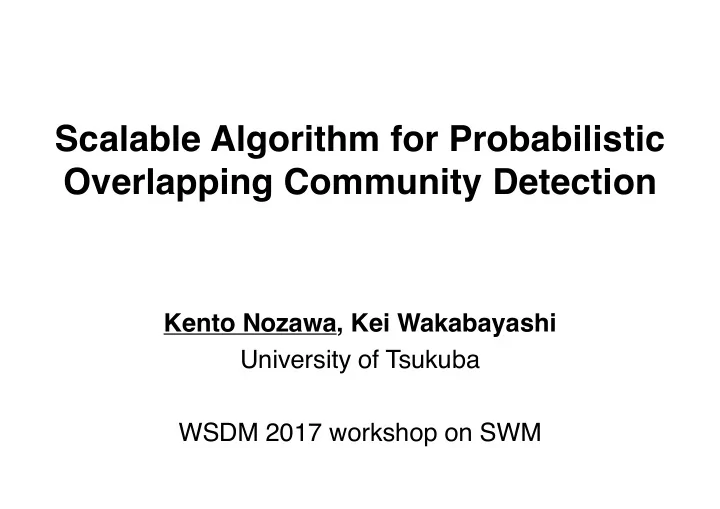

Scalable Algorithm for Probabilistic Overlapping Community Detection Kento Nozawa, Kei Wakabayashi University of Tsukuba WSDM 2017 workshop on SWM
Large Graph It’s hard to analyze a large graph. Examples: • Citation networks • Co-author relationships • Social networks • Hyperlinks on web pages Needs: Decomposition a large graph into some smaller subgraphs 2
Community Structures in Graph In the same community, • nodes are densely connected internally • nodes resemble the others – Same affiliation – Same interest – Related research area 3
Overlapping Community Each node belongs to multiple communities. Many graphs have overlapping communities – Ex. Related Research areas in co-author graph B x w E • Blue : Data mining • Red : Machine learning A y A has published in both areas C 4 D z
Bag-of-nodes Representation Bag-of-words for graph • A node corresponds to one document • The node and its adjacency list correspond to words in the document Node as doc Nodes as words A, B, C, D, A E, x, y, z w B B, A, E B x E C C, D, E, A D D, E, C, A A y E E, B, A, C, D x x, y, A, w C y y, A, x, z z z z, y, A D w w, x Graph 5 Bag-of-nodes
Latent Dirichlet Allocation (LDA) [Blei+, 2003] • Probabilistic generative model for bag-of-words • Find topics from words co-occurrence • Each topic defines a distribution over all words Coffee shop author 0.14 coffee 0.15 drink drink cite 0.12 drink 0.15 citation 0.11 coffee coffee beans 0.14 review 0.11 cafe 0.13 coffee coffee … … beans beans espresso cafe Topics (distribution over all words) Documents (bag-of-words) 6
LDA for Graph A topic represents an overlapping community. Each community is an affiliation probability distribution over nodes. Node as doc Nodes as words E , C , D , B and A belong to A, B, C, D, the community with high probability A E, x, y, z B B, A, E E 0.20 x 0.22 C C, D, E, A C 0.20 y 0.22 D 0.18 z 0.20 D D, E, C, A B 0.18 A 0.15 E E, B, A, C, D A 0.12 w 0.07 x x, y, A, w x 0.04 C 0.05 y y, A, x, z y 0.03 D 0.04 z 0.03 B 0.04 z z, y, A w 0.02 E 0.01 w w, x Graph as documents Communities (distributions over nodes) 7
Stochastic Variational Inference [Mimno+, 2012] Inference algorithms based on stochastic gradient descent – Update parameters based on sampling nodes in each iteration – mini-batch size : # sampling nodes as document Node as doc Nodes as words A, B, C, D, A Node Nodes E, x, y, z as doc as words B B, A, E B B, A, E C C, D, E, A D D, E, C, A C C, D, E, A E E, B, A, C, D z z, y, A x x, y, A, w sampling w w, x y y, A, x, z When mini-batch size is 4 z z, y, A w w, x 8 Graph as documents
Experiment Evaluation of scalability for the graph size • Runtime for overlapping community detection Quality metrics for overlapping communities • Triangle participation ratio (TPR) – Ratio of #nodes that belong to a triangle – Higher is better • Conductance – Ratio of #edges that link to an outer node – Lower is better 9
Experimental Datasets Name #nodes #edges DBLP 317,080 1,049,866 Orkut 3,072,441 117,185,083 Friendster 65,608,366 1,806,067,135 From SNAP Datasets Only Friendster: • Store into MySQL • Sample mini-batch size records from the table 10
Comparison of Runtime 2hours 7 min. #communities: 4,000 #iterations: 1,000 Mini-batch size: 2,000 11
The Metrics of DBLP Communities TPR: the median of SVBLDA is the third best Conductance: the median of SVBLDA is the third worst #communities: 4,000 #iterations: 1,000 12 Mini-batch size: 2,000
Parameter Sensitivity in DBLP • Varying mini-batch size or # iterations when fixing the other parameter • No significantly improvement of TPR/Conductance when mini-batch size > 3000 or # iterations > 2000 13 Mini-batch size: 2,000 #iterations: 1,000
Conclusion • Scalable community detection algorithm based on LDA for large graph • About 2 hours to detect communities from the large graph • It’s unnecessary to set large mini-batch size and #iteration for DBLP datasets 14
Recommend
More recommend